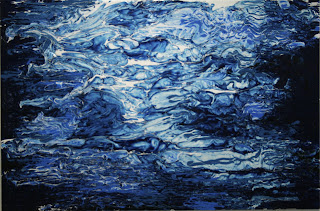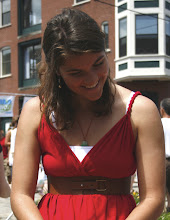 This is the last piece from this semester. I broke through some barriers on this one; never have I handled color in such an exciting way. This painting is of a backside view of Capital Peak, a 14er that I see every time I drive into Snowmass. It is truly an impressive peak, not only because it is one of the more deadly 14ers, but also because of its sheer walls that stand above the lake in the basin that it forms. The hike to Capital Lake is only 7 miles, but it holds a special importance for me because it was one of my first long hikes when I was younger. I remember being in awe of the enormous mountain when we arrived to the basin below the rock face.
This is the last piece from this semester. I broke through some barriers on this one; never have I handled color in such an exciting way. This painting is of a backside view of Capital Peak, a 14er that I see every time I drive into Snowmass. It is truly an impressive peak, not only because it is one of the more deadly 14ers, but also because of its sheer walls that stand above the lake in the basin that it forms. The hike to Capital Lake is only 7 miles, but it holds a special importance for me because it was one of my first long hikes when I was younger. I remember being in awe of the enormous mountain when we arrived to the basin below the rock face.  This painting really gave me a chance to explore the possibilities of abstraction to make a realistic form. This is a painting of the butte that stands above Grand Junction. The butte is the first indication that the mountains are coming as you drive eastward from Utah into Colorado. I had a lot of fun with the sedimentary fins and piles at the base of the butte.
This painting really gave me a chance to explore the possibilities of abstraction to make a realistic form. This is a painting of the butte that stands above Grand Junction. The butte is the first indication that the mountains are coming as you drive eastward from Utah into Colorado. I had a lot of fun with the sedimentary fins and piles at the base of the butte. This was the first of these three paintings. This painting represented a major shift in my painting style. Here, I forced myself to work continuously on a painting for an entire month; something I had never done before. I tend to like to work alla prima and to move quickly. This experience gave me a chance to explore a whole new vocabulary of technique. I enjoyed amplifying the colors and creating interesting textures over time. This painting is of the Needles section of Canyonlands.
This was the first of these three paintings. This painting represented a major shift in my painting style. Here, I forced myself to work continuously on a painting for an entire month; something I had never done before. I tend to like to work alla prima and to move quickly. This experience gave me a chance to explore a whole new vocabulary of technique. I enjoyed amplifying the colors and creating interesting textures over time. This painting is of the Needles section of Canyonlands.The best part about this technique is its transience. None of these works survives for longer than an hour. Just as our memories capture a particular moment in a constantly changing landscape, these paintings are caught by a camera, and then washed off. The painting, just like a memory, only exists as a snapshot, no longer existing outside of documentation.
 This is a shot of Matt's back from the side. There are some difficulties with painting on people. Acrylic paint does not really like skin. It doesn’t adhere well, dries in less than a minute, and cracks horribly. I however, enjoy the experience this creates for me as a painter. Working on skin forces me to make decisions quickly about blending, color, and composition. If I don’t get the paint down quickly, I can’t blend and whole chunks of paint come off on my brush.
This is a shot of Matt's back from the side. There are some difficulties with painting on people. Acrylic paint does not really like skin. It doesn’t adhere well, dries in less than a minute, and cracks horribly. I however, enjoy the experience this creates for me as a painter. Working on skin forces me to make decisions quickly about blending, color, and composition. If I don’t get the paint down quickly, I can’t blend and whole chunks of paint come off on my brush.  Matt's landscape...a mountain near Independence Pass as the sun goes down.
Matt's landscape...a mountain near Independence Pass as the sun goes down. I wanted to include myself in this project, but painting on myself presented a whole new level of difficulty. In order to do so, I had to use a mirror and a reflected image. This was a difficult process; I had learn how to hold the brush differently, and I had to take the geography of my chest into account. Painting on the chest and breasts is slightly more confusing than painting on a back; there are many more contours. My landscape is Mount Sopris.
I wanted to include myself in this project, but painting on myself presented a whole new level of difficulty. In order to do so, I had to use a mirror and a reflected image. This was a difficult process; I had learn how to hold the brush differently, and I had to take the geography of my chest into account. Painting on the chest and breasts is slightly more confusing than painting on a back; there are many more contours. My landscape is Mount Sopris. Raya's back....her family's dock in White Lake, New York.
Raya's back....her family's dock in White Lake, New York. Emily's landscape...Chicago at night.
Emily's landscape...Chicago at night. Madelyn in a completed shelter, ready for nap time.
Madelyn in a completed shelter, ready for nap time. Matt and Kirsten in a less functional shelter...this one became more of a fort. Two people could comfortably hang out in this shelter
Matt and Kirsten in a less functional shelter...this one became more of a fort. Two people could comfortably hang out in this shelter Shelters in progress
Shelters in progress The skeleton of the shelter is much like an overturned boat. The leaves provide insulation above this lattice work of branches. They are quite sturdy.
The skeleton of the shelter is much like an overturned boat. The leaves provide insulation above this lattice work of branches. They are quite sturdy. People enjoying the leaf piles...our main material.
People enjoying the leaf piles...our main material. Completed Nest! I can put process photos of it up later if people are interested...it took about 6 hours to build.
Completed Nest! I can put process photos of it up later if people are interested...it took about 6 hours to build. Here is a single leaf I painted with oil paint. I used blue because it seemed the most surprising color for an autumn leaf. The oil paint was quite resilient...the paint never came off the leaf fully. I noticed people checking this leaf out from time to time. This was an interesting (but failed, I think) project.
Here is a single leaf I painted with oil paint. I used blue because it seemed the most surprising color for an autumn leaf. The oil paint was quite resilient...the paint never came off the leaf fully. I noticed people checking this leaf out from time to time. This was an interesting (but failed, I think) project. This is a leaf mobile I made using sticks and a color gradient of fall leaves. The leaves were then strung on wire and put into a spiral made of sticks. It moved quite nicely in the wind, but was not too ostentatious. This is just one mobile in a series of 4. The other four didn't turn out quite as nicely.
This is a leaf mobile I made using sticks and a color gradient of fall leaves. The leaves were then strung on wire and put into a spiral made of sticks. It moved quite nicely in the wind, but was not too ostentatious. This is just one mobile in a series of 4. The other four didn't turn out quite as nicely. Another view of the leaf-mobile.
Another view of the leaf-mobile. Mobile materials in my studio.
Mobile materials in my studio.































